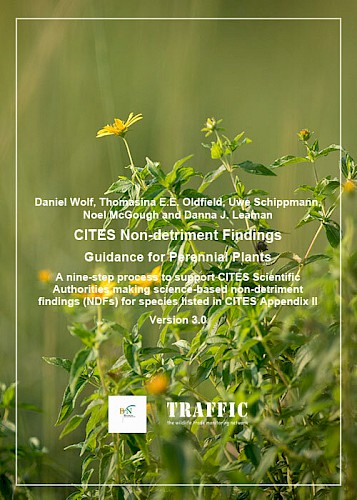
Ensuring trade is within sustainable limits is at the core of the Convention on International Trade in Endangered Species of Wild Fauna and Flora (CITES). According to the Convention, Parties shall allow trade in specimens of species included in Appendix II only if the Scientific Authority of the State of export has advised that “such export will not be detrimental to the survival of that species" (Article IV).
Further, “a Scientific Authority in each Party shall monitor both the export permits granted by that State for specimens of species included in Appendix II and the actual exports of such specimens. Whenever a Scientific Authority determines that the export of specimens of any such species should be limited in order to maintain that species throughout its range at a level consistent with its role in the ecosystems in which it occurs and well above the level at which that species might become eligible for inclusion in Appendix I, the Scientific Authority shall advice the appropriate Management Authority of suitable measures to be taken to limit the grant of export permits for specimens of that species” (Article IV).
Collectively these requirements are referred to as ‘non-detriment findings’ (NDFs). How NDFs are made for Appendix II species is the responsibility of the Scientific Authority of each exporting Party. The Conference of the Parties (CoP) has decided not to adopt specific technical criteria for how NDFs are undertaken, instead the CoP adopted non-binding general guidelines on making NDFs, outlined in Resolution Conf. 16.7 (Rev. CoP17) on Non-detriment findings.
Considerable efforts have been made by some Parties, IGOs, and the Secretariat over the years to develop general and taxon-specific guidance for making NDFs; in particular, significant advances have been achieved for plant taxa.
Key milestones include:
Version 4.0 has built on version 3.0 and incorporated feedback from experts and from participants in training workshops and the outcomes from the CITES NDF project and the results of the above-mentioned international expert workshop on NDF in December 2023, particularly module 2 on generic framework for NDFs and guidance for plant species in module 11. We recommend referring to those modules for further detail.
The 9-Steps can be seen as a tool to implement the CITES comprehensive generic framework recommended to be applied by Parties at this workshop. The guidance has also been updated with the latest decisions at CoP 19. New features developed include an online training course that can be found on the dedicated 9-Step website. The worksheets that accompany the guidance that can be used to record information whilst making your NDF have additionally been developed into an online decision tree which provides an online 9-Step NDF format. We thank all those that have enthusiastically engaged in workshops from whom we have learnt a vast amount and improved the guidance based on lessons from them.
Although this document is intended to guide a Scientific Authority towards a decision using the best available information, ultimately it will be necessary for the Scientific Authority to weigh up the risks and evidence to make its final NDF decision. This will require individual (or group) judgments; this Guidance is designed to draw out the information relevant to informing the process that leads to that final decision. For further guidance on making NDFs in low data situations and how adaptive management can be a means to acquiring extra data see CITES NDF Guidance module 1.
This Guidance suggests nine steps that a Scientific Authority can take to make a science-based NDF.
Each of the Guidance steps is comprised of the following components:
A set of Consolidated Worksheets is also provided in a separate MS Excel file. These worksheets can be used to record the sources consulted, the information relevant to each of the steps, and the outcome of the process. The Consolidated Worksheets may be used as a draft report format for the final NDF. You can also make use of the online decision tree below.
This Guidance is not intended to automatically generate the NDF-decision of a Scientific Authority, rather is it a tool to assist in making a well-informed decision using the best available information. Anyone using the framework must use their own judgement; they may not agree with the level of risk the Guidance points to and are likely to have better insight than a generic tool or they may have less confidence in the available information. Assessing the risks is intended to guide someone to the level of detail and confidence that they have in the management that ensures the harvest and trade is going to be non-detrimental. The Guidance helps structure the relevant aspects and information to facilitate an individual conclusion on detriment. This guide is not exhaustive, but we hope we have struck the right balance of sufficient guidance, useability and length.
This Guidance and the associated Consolidated Worksheets and online training tools on the dedicated website can be used in various ways, including:
We suggest referring to the Guidance from the CITES NDF project particularly to module 11 for plants, as well as modules 1 and 2 for general NDF guidance. While we have integrated most elements of relevance for this guidance we have not incorporated the simplified assessments for trade where it is likely to be simple to determine non-detriment as proposed in Module 2 into the 9-Steps approach. However, a simpler route is possible when a lower risk scenario indicates that less rigour and information are needed to determine non-detriment.
All links to online documents were checked and updated in June 2024, however, links may change over time, particularly after CoP meetings. If you cannot access a CITES document, please use the document section on CITES website. All CITES Resolutions are referred to in the text as Res. or Resolution.
Start Decision Process